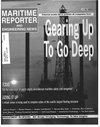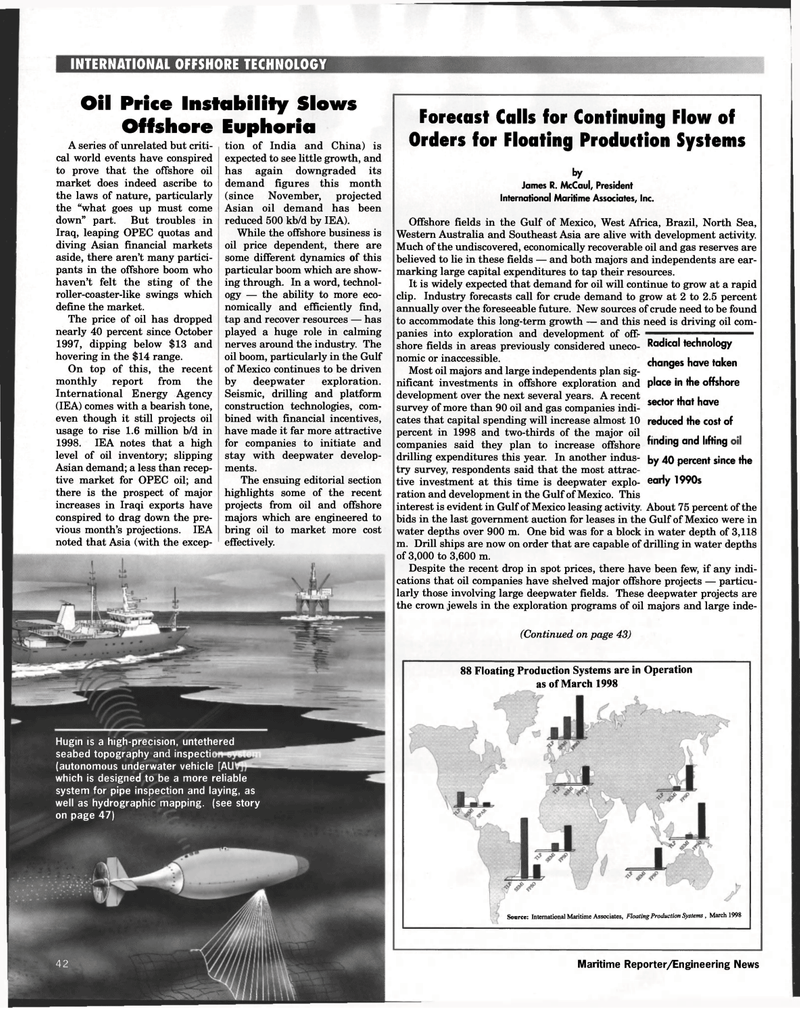
Page 50: of Maritime Reporter Magazine (April 1998)
Read this page in Pdf, Flash or Html5 edition of April 1998 Maritime Reporter Magazine
INTERNATIONAL OFFSHORE TECHNOLOGY
Oil Price Instability Slows
Offshore Euphoria
A series of unrelated but criti- cal world events have conspired to prove that the offshore oil market does indeed ascribe to the laws of nature, particularly the "what goes up must come down" part. But troubles in
Iraq, leaping OPEC quotas and diving Asian financial markets aside, there aren't many partici- pants in the offshore boom who haven't felt the sting of the roller-coaster-like swings which define the market.
The price of oil has dropped nearly 40 percent since October 1997, dipping below $13 and hovering in the $14 range.
On top of this, the recent monthly report from the
International Energy Agency (IEA) comes with a bearish tone, even though it still projects oil usage to rise 1.6 million b/d in 1998. IEA notes that a high level of oil inventory; slipping
Asian demand; a less than recep- tive market for OPEC oil; and there is the prospect of major increases in Iraqi exports have conspired to drag down the pre- vious month's projections. IEA noted that Asia (with the excep- tion of India and China) is expected to see little growth, and has again downgraded its demand figures this month (since November, projected
Asian oil demand has been reduced 500 kb/d by IEA).
While the offshore business is oil price dependent, there are some different dynamics of this particular boom which are show- ing through. In a word, technol- ogy — the ability to more eco- nomically and efficiently find, tap and recover resources — has played a huge role in calming nerves around the industry. The oil boom, particularly in the Gulf of Mexico continues to be driven by deepwater exploration.
Seismic, drilling and platform construction technologies, com- bined with financial incentives, have made it far more attractive for companies to initiate and stay with deepwater develop- ments.
The ensuing editorial section highlights some of the recent projects from oil and offshore majors which are engineered to bring oil to market more cost effectively.
Forecast Calls for Continuing Flow of
Orders for Floating Production Systems by
James R. McCaul, President
International Maritime Associates, Inc.
Offshore fields in the Gulf of Mexico, West Africa, Brazil, North Sea,
Western Australia and Southeast Asia are alive with development activity.
Much of the undiscovered, economically recoverable oil and gas reserves are believed to lie in these fields — and both majors and independents are ear- marking large capital expenditures to tap their resources.
It is widely expected that demand for oil will continue to grow at a rapid clip. Industry forecasts call for crude demand to grow at 2 to 2.5 percent annually over the foreseeable future. New sources of crude need to be found to accommodate this long-term growth — and this need is driving oil com- panies into exploration and development of off- shore fields in areas previously considered uneco- nomic or inaccessible.
Most oil majors and large independents plan sig- nificant investments in offshore exploration and development over the next several years. A recent survey of more than 90 oil and gas companies indi- cates that capital spending will increase almost 10 percent in 1998 and two-thirds of the major oil companies said they plan to increase offshore findin9 and llfHn9 drilling expenditures this year. In another indus- by 40 percent since the try survey, respondents said that the most attrac- tive investment at this time is deepwater explo- early 1990s ration and development in the Gulf of Mexico. This interest is evident in Gulf of Mexico leasing activity. About 75 percent of the bids in the last government auction for leases in the Gulf of Mexico were in water depths over 900 m. One bid was for a block in water depth of 3,118 m. Drill ships are now on order that are capable of drilling in water depths of 3,000 to 3,600 m.
Despite the recent drop in spot prices, there have been few, if any indi- cations that oil companies have shelved major offshore projects — particu- larly those involving large deepwater fields. These deepwater projects are the crown jewels in the exploration programs of oil majors and large inde-
Radical technology changes have taken place in the offshore sector that have reduced the cost of
Hugin is a high-precision, untethered seabed topography and inspecti (autonomous underwater vehicle [All which is designed to be a more reliable system for pipe inspection and laying, as well as hydrographic mapping, (see story on page 47) 88 Floating Production Systems are in Operation as of March 1998 (Continued on page 43)
Source: International Maritime Associates, Floating Production Systems , March 1998
Maritime Reporter/Engineering News

 49
49

 51
51
